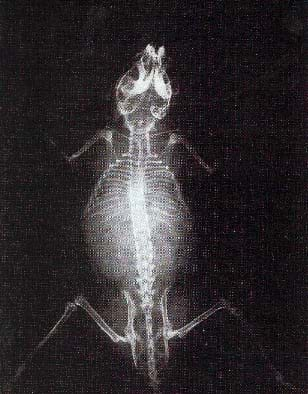
Summary
Students examine an image produced by a cabinet x-ray system to determine if it is a quality bone mineral density image. They write in their journals about what they need to know to be able to make this judgment. Students learn about what bone mineral density is, how a BMD image can be obtained, and how it is related to the x-ray field. Students examine the process used to obtain a BMD image and how this process is related to mathematics, primarily through logarithmic functions. They study the relationship between logarithms and exponents, the properties of logarithms, common and natural logarithms, solving exponential equations and Beer's law.Engineering Connection
Biomedical engineering consists of the application of engineering principles and techniques to the fields of medicine and life sciences. The process of calculating a small specimen bone mineral density image using a cabinet x-ray system us useful in determining the effectiveness of medications and treatments in medical research.
Unit Overview
This "legacy cycle" unit is structured with a contextually-based Grand Challenge followed by a sequence of instruction in which students first offer initial predictions (Generate Ideas) and then gather information from multiple sources (Multiple Perspectives) . This is followed by Research and Revise as students integrate and extend their knowledge through a variety of learning activities. The cycle concludes with formative (Test Your Mettle) and summative (Go Public) assessments that lead students towards answering the Challenge question. See below for the progression of the legacy cycle through the unit. Research and ideas behind this way of learning may be found in How People Learn,(Bransford, Brown & Cocking, National Academy Press, 2000); see the entire text at https://www.nap.edu/read/9853/chapter/1.
The "legacy cycle" is similar to the "engineering design process" in that they both involve identifying an existing societal need, combining science and math to develop solutions, and using the research conclusions to design a clear, conceived solution to the original challenge. Though the engineering design process and the legacy cycle depend on correct and accurate solutions, each focuses particularly on how the solution is devised and presented. See an overview of the engineering design process at https://www.teachengineering.org/engrdesignprocess.php
Educational Standards
Each TeachEngineering lesson or activity is correlated to one or more K-12 science,
technology, engineering or math (STEM) educational standards.
All 100,000+ K-12 STEM standards covered in TeachEngineering are collected, maintained and packaged by the Achievement Standards Network (ASN),
a project of D2L (www.achievementstandards.org).
In the ASN, standards are hierarchically structured: first by source; e.g., by state; within source by type; e.g., science or mathematics;
within type by subtype, then by grade, etc.
Each TeachEngineering lesson or activity is correlated to one or more K-12 science, technology, engineering or math (STEM) educational standards.
All 100,000+ K-12 STEM standards covered in TeachEngineering are collected, maintained and packaged by the Achievement Standards Network (ASN), a project of D2L (www.achievementstandards.org).
In the ASN, standards are hierarchically structured: first by source; e.g., by state; within source by type; e.g., science or mathematics; within type by subtype, then by grade, etc.
See individual lessons and activities for standards alignment.
Subscribe
Get the inside scoop on all things TeachEngineering such as new site features, curriculum updates, video releases, and more by signing up for our newsletter!Unit Schedule
- Day 1-2: Bone Density Challenge Introduction lesson
- Day 3: Exploring Bone Mineral Density activity
- Day 4: Bone Density Math and Logarithm Introduction lesson
- Day 5: Common and Natural Logarithms and Solving Equations lesson
- Day 6: Linear Regression of Bone Mineral Density Scanners activity
- Day 7: Bone Mineral Density Math and Beer's Law lesson
- Day 8: Light Intensity Lab activity
More Curriculum Like This

Students are introduced to the challenge question, which revolves around proving that a cabinet x-ray system can produce bone mineral density images. Students work independently to generate ideas from the questions provided, then share with partners and then with the class as part of the Multiple Pe...

Through this unit, written for an honors anatomy and physiology class, students become familiar with the human skeletal system and answer the Challenge Question.

Students revisit the mathematics required to find bone mineral density, to which they were introduced in lesson 2 of this unit. They learn the equation to find intensity, Beer's law, and how to use it. Then they complete a sheet of practice problems that use the equation.

Students continue an examination of logarithms in the Research and Revise stage by studying two types of logarithms—common logarithms and natural logarithm. They take notes about the two special types of logarithms, why they are useful, and how to convert to these forms by using the change of base f...
Assessment
Throughout the lessons and activities, homework assignments cover conversion between exponents and logarithms, logatithm properties, common logarithms, natural logarithms, change of base formula, Beer's law and solving exponential equations. All these serve as assessment tools. The concluding assessment (in the final lesson, lesson 4) is students' answer to the challenge question, which may be in the form of a pamphlet, poster or presentation.
Copyright
© 2013 by Regents of the University of Colorado; original © 2006 Vanderbilt UniversityContributors
Kristyn Shaffer ; Megan JohnstonSupporting Program
VU Bioengineering RET Program, School of Engineering, Vanderbilt UniversityAcknowledgements
The contents of this digital library curriculum were developed under National Science Foundation RET grant nos. 0338092 and 0742871. However, these contents do not necessarily represent the policies of the NSF, and you should not assume endorsement by the federal government.
Last modified: February 13, 2020







User Comments & Tips